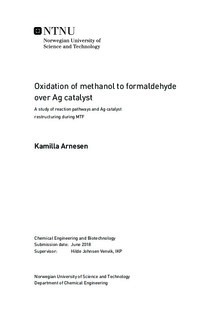| dc.description.abstract | Formaldehyde is recognised as an important industrial chemical, being a versatile organic molecule. Due to high reactivity, it is used as a building block to synthesise other chemicals and industrial products. Production of formaldehyde is mainly based on two reactions, dehydrogenation and partial oxidation of methanol. Silver can be used as a catalyst and the technology is recognised by Dynea AS as the process method with most potential for competitive development, based on market and environmental considerations.
In this master thesis silver catalyst morphology, activity and interaction between silver and various components relevant to the formaldehyde synthesis have been studied. The catalytic morphology was investigated for dependency on different atmospheres, exposure time and process variables. Catalytic activity was measured for hydrogen, carbon monox- ide and, to an extent, methanol oxidation reactions, in addition to focusing on structure dependencies. The catalyst was characterised with XRD and SEM.
Polycrystalline silver catalyst was treated with various atmospheres, such as nitrogen, hy- drogen, air and methanol/water, at elevated temperatures. It was also used as the catalyst in oxidation reactions, performed with varying temperatures, to investigate the levels of reactant conversion.
It was found that treating the silver with different atmospheres resulted in great changes of the silver surface and morphology. Structural changes in the silver was observed when oxygen was present. Silver particles treated in air showed increasing restructuring with time, eliminating angular grain structure, production of pinholes and promoting irregular and smooth facet formation. Using the silver as a catalyst for hydrogen, carbon monoxide and methanol oxidation resulted in the same observations. Equal morphological changes were observed on the mesoscale, for silver used as catalyst in hydrogen and carbon monox- ide oxidation. The catalyst display high catalytic activity for hydrogen oxidation, increas- ing with time. A declining trend was evident for catalytic activity for carbon monoxide oxidation, suggesting the restructured silver promotes hydrogen oxidation, as opposed to carbon monoxide oxidation. In general, oxygen display an important role promoting and activating reactions and influence the silver catalyst morphology. This is especially critical for silver catalyst activation and performance during process start-up in the formaldehyde production. | |

